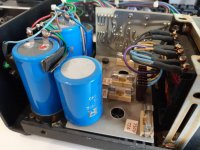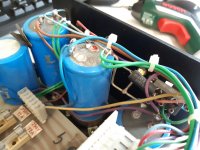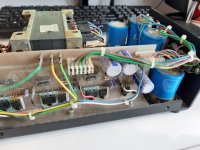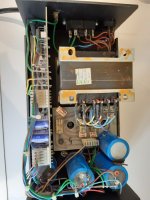Hi,
I'm planning to replace the electrolytics in my mixing desk power supply. It's a Studiomaster 20 channel, 16 bus desk from 1986 and it now has a very quiet, but noticeable background hum. I thought that replacing the main filter caps would be a good place to start.
The power supply is external and has +-15V rails for the audio circuits, single +15V rail for the displays and +48V for the phantom power. The main filter capacitors are the old, light blue, type with solder tags, clamped to the casing and wired together with thick bus wire. There are also several smaller radial electrolytics on the board.
I've got a few questions about replacing them. Firstly, do you think it's necessary on a board of that age? I have replaced power caps on noisy amplifiers newer than that but have older pieces of equipment that have never been touched and are still quiet.
Assuming I do replace them, the physical size of the capacitors is a bit of a problem. The way that the connections are made, with a network of bus wire, means that the shorter packages will be a bit of a pain to fit. Has anyone come up with a good way to fit newer, smaller capacitors into older power supplies? The main supply caps are currently 6800uF. Using a larger value would give a physical package size more like the old ones. I've seen people do this before but I'm not sure if it's advisable or not.
Any tips would be greatly appreciated!
Thanks,
James
I'm planning to replace the electrolytics in my mixing desk power supply. It's a Studiomaster 20 channel, 16 bus desk from 1986 and it now has a very quiet, but noticeable background hum. I thought that replacing the main filter caps would be a good place to start.
The power supply is external and has +-15V rails for the audio circuits, single +15V rail for the displays and +48V for the phantom power. The main filter capacitors are the old, light blue, type with solder tags, clamped to the casing and wired together with thick bus wire. There are also several smaller radial electrolytics on the board.
I've got a few questions about replacing them. Firstly, do you think it's necessary on a board of that age? I have replaced power caps on noisy amplifiers newer than that but have older pieces of equipment that have never been touched and are still quiet.
Assuming I do replace them, the physical size of the capacitors is a bit of a problem. The way that the connections are made, with a network of bus wire, means that the shorter packages will be a bit of a pain to fit. Has anyone come up with a good way to fit newer, smaller capacitors into older power supplies? The main supply caps are currently 6800uF. Using a larger value would give a physical package size more like the old ones. I've seen people do this before but I'm not sure if it's advisable or not.
Any tips would be greatly appreciated!
Thanks,
James
Fitting a smaller cap is simply a case of making some sort of adapter for it to fit, easier than
the opposite problem! Are the existing one's in a clamp of some sort?
1986 - if its been in regular use I'd say its time to change them, or at least disconnect and measure capacitance, ESR and leakage.
Hum can be caused by other factors, so this might not fix that.
the opposite problem! Are the existing one's in a clamp of some sort?
1986 - if its been in regular use I'd say its time to change them, or at least disconnect and measure capacitance, ESR and leakage.
Hum can be caused by other factors, so this might not fix that.
An easy way is to use larger rated voltage ones (you may go up to one or two steps safely). I mean, for example, use 35V or 50/63V rated caps instead of 25V rated, etc.Has anyone come up with a good way to fit newer, smaller capacitors into older power supplies? The main supply caps are currently 6800uF. Using a larger value would give a physical package size more like the old ones.
Sometimes you may increase capacity too (but not everywhere, that way needs at least a simple look and analysis of a circuit).
Last edited:
Hi,
I've attached pictures of the power supply from different angles. The power caps are fixed using clamps. I've fitted smaller caps before by padding out the clamp with some plastic but the main problem is the height. I'm thinking that the best strategy would be to extend the capacitor terminals upwards to meet the bus wire rather than trying to bring the connections down.
Thanks,
James
I've attached pictures of the power supply from different angles. The power caps are fixed using clamps. I've fitted smaller caps before by padding out the clamp with some plastic but the main problem is the height. I'm thinking that the best strategy would be to extend the capacitor terminals upwards to meet the bus wire rather than trying to bring the connections down.
Thanks,
James
Attachments
I've used equivalent gauge stranded wire with fork or ring terminals crimped on the end to replace heavy gauge bus wire. The soldering will be up on the bus wire in the air, away from the cap which might be damaged by that much heat. Screw terminal caps are still available.
When I re-e-cap I use product rated 3000 or higher service life hours. Least cost of repair is not my goal. Not doing the job again in 5-7 years is my goal.
If the old clamps don't fit, you can use glue instead. Suitable glue is wallboard adhesive or 3M weatherstrip adhesive. Screw caps I bought came with new clamps for the smaller size. I had to redrill some holes in the case. Don't buy wallboard adhesive that meets California Air board requirements for VOC. It doesn't work. I don't know why the home stores even clutter the shelves with that trash.
When I re-e-cap I use product rated 3000 or higher service life hours. Least cost of repair is not my goal. Not doing the job again in 5-7 years is my goal.
If the old clamps don't fit, you can use glue instead. Suitable glue is wallboard adhesive or 3M weatherstrip adhesive. Screw caps I bought came with new clamps for the smaller size. I had to redrill some holes in the case. Don't buy wallboard adhesive that meets California Air board requirements for VOC. It doesn't work. I don't know why the home stores even clutter the shelves with that trash.
Last edited:



